Mental stimulation toys for dogs can be a great way to engage your dog’s brain at any age. Integrative veterinarian Dr. Julie Buzby shares 13 mental stimulation toys and games for dogs. With all these options, you are sure to find some that are a hit with your pup (and you too)!
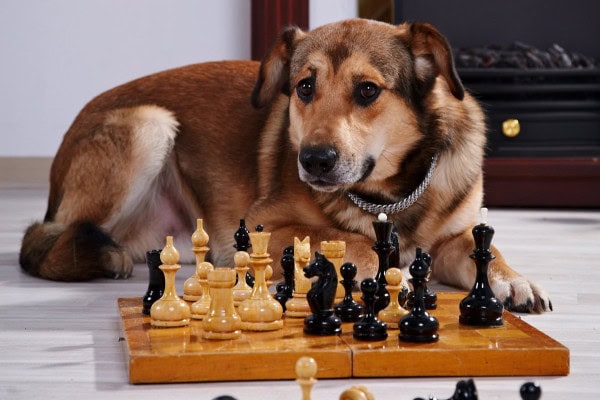
Do you ever have those days where you are restless and feel like you need to do something to work your brain or body? I know I do… and so do our dogs!
Mental stimulation is very important for dogs. And it is a necessary part of your dog’s overall health and wellbeing. So how do you provide your dog the mental simulation he or she craves?
There are a variety of ways to do this. Some of the most popular options are mental stimulation toys for dogs and mentally stimulating games or activities. Before we get into some of my favorites, let’s discuss the benefits of canine mental stimulation.
Why is mental stimulation important for dogs?
Like humans, a dog’s mental health is equally as important as his or her physical health. Dogs who are stressed, fearful, bored, or not challenged enough are less likely to have the best life possible. And they are at higher risk for behavioral issues (e.g. destructive behavior or anxiety). But the great news is that mental stimulation can help reduce anxiety and compulsive disorder in dogs.
Mental stimulation is great for dogs with canine cognitive dysfunction
Additionally, keeping a senior dog’s brain engaged can help decrease the risk of developing canine cognitive dysfunction (CCD). Otherwise known as sundowners in dogs or doggy dementia, CCD is sadly quite common in our senior friends. It may affect 28% of dogs who are 11 to 12 years old, 48% of dogs by the age of 14, and 68% of 16-year-old dogs. So anything we can do to help keep our dogs’ brains young is well worth considering.
Plus, the great thing about mental stimulation is that it can also help slow down the progression of CCD. And many dog parents report it improves the signs of dementia in dogs.
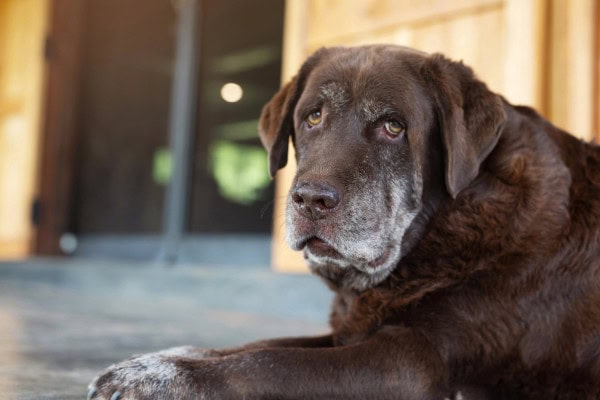
Mental stimulation helps dogs stay relaxed during crate rest
Next, providing mental stimulation for dogs on crate rest is also extremely important. Crate rest after an injury or surgery (e.g. TPLO surgery for dogs or a total hip replacement in dogs) can be long and boring for dogs. This is especially the case for younger dogs who are used to being active and playing throughout the day.
Providing interactive dog toys or activities for dogs on crate rest can reduce the stress associated with the crate. Additionally, dogs who are not as bored in the crate are less likely to chew on their incision, bandages, or wounds.
Mental stimulation is great for puppies and adult dogs too
But I don’t want you to think that only dogs on crate rest or senior dogs need mental stimulation. It is important for all dogs—even puppies. Mentally stimulating toys and activities can help puppies learn more quickly. And these toys or activities teach them to use their brains rather than just running around the house in an adorable frenzy. (Not that they won’t still do that sometimes—they are puppies after all.)
Plus, learning new tricks or playing games like hide and seek are a great way for dog parents to bond with and have fun with their dogs of any age.
In short, mental stimulation is beneficial for every dog, regardless of their age or situation.
Mental stimulation toys for dogs
You can buy many different excellent dog toys for mental stimulation. And there are plenty of homemade toys as well! Below are some of my favorite options to use with my own dogs or with my patients.
1. Puzzle games
Puzzle games are probably one of the most common options that dog parents use to provide mental stimulation for dogs. These puzzle toys are wonderful because they are all unique and interactive. Many involve a dog solving the puzzle for a food reward—usually pieces of kibble or treats that you place within the puzzle toy.
I like puzzle games for dogs who are bored or on crate rest (if the toy is small enough to fit in the crate and still allow your dog to solve it). Plus, they are a great way to stimulate the brain in our senior pups—which can help prevent or slow the progression of CCD.
You can use puzzles for puppies too, but not all puppies have the necessary attention span. Thus, some puppies might need an easier puzzle until they can pay attention for longer periods of time.
While there are various puzzle toys on the market, a favorite among our team at Dr. Buzby’s are the Nina Ottosson puzzle toys by Outward Hound (pictured below).
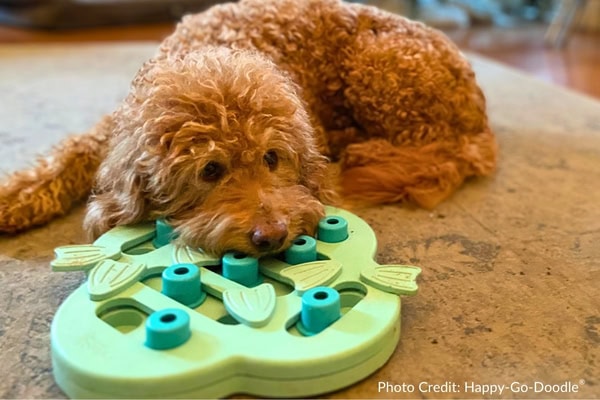
Among other things, the team members like that there are different difficulty levels for the puzzles and that they are safe and easy to clean.
And of course their dogs—including a team member’s blind dog—love doing their Nina Ottosson puzzle toys too!
Start with an easier puzzle toy and work up to harder ones
As mentioned, one of the great things about puzzle toys is that they come in different difficulty levels. This allows you to pick the one that is right for your dog’s skill level and attention span.
If you have never played games or used a puzzle toy with your dog before, many dog parents find it best to start out with an easier level puzzle. Even if your dog is very smart, starting with an simple puzzle allows you to help teach your dog how to work a puzzle toy.
Starting with an easier puzzle also means your dog can solve it quickly. This helps him or her learn that there is a positive reward (like a treat) associated with the puzzle. If your dog starts with a hard puzzle and it takes too long to get the treat out, he or she may become bored and give up. This could discourage your dog and make it less likely that he or she would want to do the puzzle again in the future.
Just like when teaching a dog a new trick, lots of rewards and positive reinforcement are necessary when introducing puzzle toys. As your dog learns how to push the levers, move pieces, and work other parts of the puzzle, you can progress in difficulty level until you find the toy that provides the perfect amount of entertainment and mental stimulation for your dog.
2. Treat dispensing toys
If treats or food easily motivate your dog (like many of my Labrador patients), then the best mental stimulation toy for your dog may be treat dispensing toys.
Just like many puzzle games, these toys are designed to dispense a treat or piece of food when the dog plays with it. But some of the treat dispensing toys do not require your dog “solving” something more complex like a puzzle.
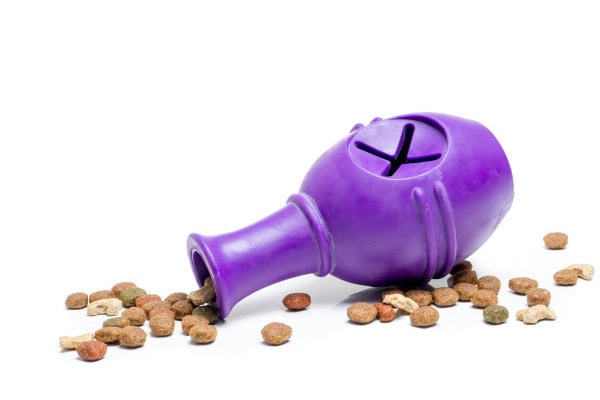
The most common toys that are treat dispensers come in the form of a ball. As your dog pushes the treat ball around, the reward falls out of it.
Treat dispensing toys are one of my favorite mentally stimulating ways to keep a dog occupied who is on crate rest. Many of these toys are smaller in size. So, they fit nicely in the crate with the dog without taking up too much room.
And they are usually less likely to pose a choking hazard or obstruction risk for dogs than some other toys. (But of course, before you put any toy in the crate with your dog, you need to inspect it closely to make sure it is safe for your dog. And you should always monitor your dog while using the toy.)
I also like treat dispensing toys for puppies. They are entertaining for puppies to push or roll around. Plus, they provide “instant gratification” for puppies who don’t always have a long attention span.
Rotate treat dispensing toys to keep your dog interested
If your dog loves the interactive treat dispensing toys and prefers them over others, I usually recommend keeping more than one on hand. By having multiple options available, you can rotate which toy is out for your dog to play with. Changing out the toy every so often will help keep your dog entertained and engaged.
3. Slow feeders
If your dog is food-motivated but not as interested in toys or puzzles, a slow feeder is another great way to provide mental stimulation. A slow feeder is a stationary dog bowl that encourages dogs to eat their food slowly by featuring a maze or obstacle in the middle of the food.
Slow feeders come in all different shapes and sizes. This makes them great mental stimulation “toys” for both small and large breed dogs. They are also available in different difficulty levels.
I think slow feeders are a wonderful option for mental stimulation for any dog. They often can fit in the crate with a dog on crate rest. And they are appropriate for senior dogs or other dogs with mobility issues because the dog can use them while lying down or without having to move around much.
Additionally, aside from the mental stimulation benefits, I often recommend slow feeders for dogs who are fast eaters. Dogs who eat their food quickly are at an increased risk of certain situations like choking or bloat in dogs (i.e. gastric dilation volvulus or GDV). Thus, a slow feeder can be a good tool to reduce the risk of those conditions.
4. Scatter feeding (a great DIY option)
If you are looking for a DIY option that is similar to slow feeders or treat dispensers, I love to recommend scatter feeding. You can use a small amount of kibble or treats for scatter feeding. Or it can be a fun way to feed a full meal to your dog.
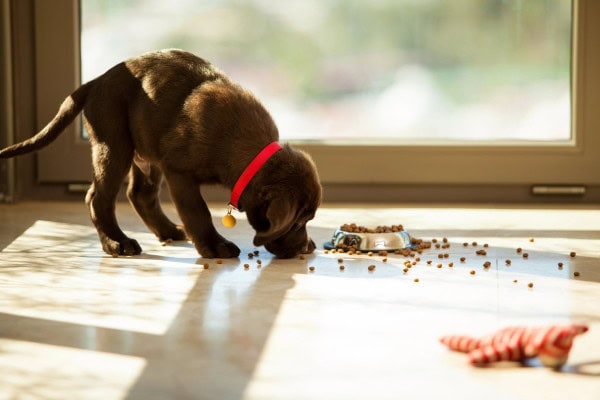
To scatter feed your dog, all you need is your dog’s regular food or treats. When you are ready to play with your dog, just toss the food in a spread-out pattern on the floor. Or you can even hide it in different places around the house.
This provides important mental stimulation because your dog must use his or her senses (such as smell and sight) to find the food. That is a lot more interesting than standing at a bowl to eat. Plus, depending on your dog’s specific needs, you can make scatter feeding as easy or difficult as you want.
5. Kong toys
Continuing with food-based entertainment, I love using Kong toys to provide mental stimulation for dogs. If you have never seen a classic Kong toy, it is a tough, snowman-shaped rubber toy that is made specifically for dogs. I love Kongs because they are very sturdy and more difficult for a dog to destroy than other chew toys. Yet they are safe for their teeth.
Kongs by themselves are fun because they can be used to play a game of fetch or hide-the-toy. But I also love to fill them with food or peanut butter as a mentally simulating activity for dogs. This gives the dog a fun thing to do. They have to maneuver the toy and work to get the food or peanut butter out.
Kongs are another wonderful option for dogs on crate rest, senior dogs, dogs who are healing from an injury or surgery, or even puppies! If you already have a Kong toy at home, you can easily stuff it with a tasty treat to turn it into something more mentally stimulating for your dog.
6. DIY frozen treats
If you know that your dog would have fun and be challenged by finding food, creating DIY frozen treats at home is another option.
Depending on your dog’s size and ability, there are many ways to make frozen treats for your dogs. One of my favorite things to do is to fill a container with water and small pieces of fruits and vegetables that are safe for dogs. Then, I stick it in the freezer so the fruit and veggies will be suspended in the ice.
When it’s time to give the frozen treat to your dog, you can pull it out of the freezer. Then let your dog get busy licking it to try to get to the food inside.
This is a very casual way for your dog to be entertained and get some mental stimulation. It will not challenge the brain as much as some of the other suggestions in this article. But it can still be helpful and fun for your dog—regardless of your dog’s age.
Also, this is a great way to provide mental stimulation while keeping your dog cool in the summer.
NOTE: This may not be the best option for a dog who wants to chew on the ice or has dental disease in dogs. The goal is to have your dog lick the ice, not bite it. Otherwise, there is the potential a hard chewer could damage his or her teeth on the ice. Or your dog may simply not like the activity if the mouth is painful due to dental disease.
7. Chewing toys
Recently, I had a client ask me, “Is chewing toys a form of mental stimulation for dogs?” She was thrilled when I said the answer was “Yes!” because her dog loved to chew on toys. However, I did caution her that it was important to select safe chew toys for dogs.
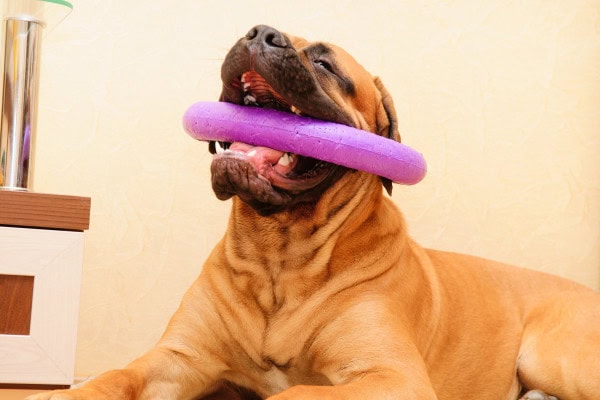
Chew toys may not challenge your dog as much as other games or toys. But they can help prevent boredom or destructive behavior—especially for dogs who become bored easily or are on crate rest.
Also, many senior dogs who are no longer interested in playing may still like special chew toys. An older dog can enjoy a chew toy while resting comfortably on the couch or dog bed. And since chewing is a sedentary activity, there isn’t the concern for overworking the dog’s potentially painful arthritic joints.
Mental stimulation games and activities for dogs
Beyond treat or food-based options, you may want to consider dog games and activities. If your dog is able to move around, these games and activities are some of my favorite ways to provide mental stimulation.
I like them for a few reasons:
- Many are free and don’t require any extra supplies.
- They encourage the human-animal bond because they require dogs and their parents to spend time together.
- These games can be played almost anywhere.
- Games and activities provide some of the best mental stimulation because they require your dog to listen and to participate.
- These games are DIY. So you can change and customize them to make them unique and specific for your dog.
8. Hide and seek
One of my favorite mentally-stimulating games is hide and seek. I have taught every one of my dogs how to play hide and seek since they were puppies.
To teach your dog hide and seek, I recommend taking your dog’s favorite treat or toy with you when you hide. This will motivate your dog to look for you. And it can serve as a reward for finding you.
9. Playing fetch
Another game you can play with your dog for mental stimulation is fetch. Many people would not think of fetch as a mentally stimulating activity. But it is! Plus, I like that it encourages dogs to be active.
Fetch can serve as mental exercise because you can incorporate other tricks into the game like “stay”, “wait”, and “go.” Also, you can make it more difficult by throwing more than one toy and teaching your dog to listen to you to know which toy to retrieve.
For example, when I play with my dog, I throw a ball and a frisbee at the same time. Then, he sits and waits for me to release him and tell him which toy to bring back.
I recognize, though, that playing fetch in these ways can get harder as our dogs approach their senior years. Pain or mobility concerns may keep them from being as active. But the good news is that you can still play a modified version of fetch.
To do this, roll the ball toward your dog while he or she is lying down. This allows your dog to still enjoy an activity that he or she loves. But you don’t have to worry about making your dog more sore or tired.
10. Agility training
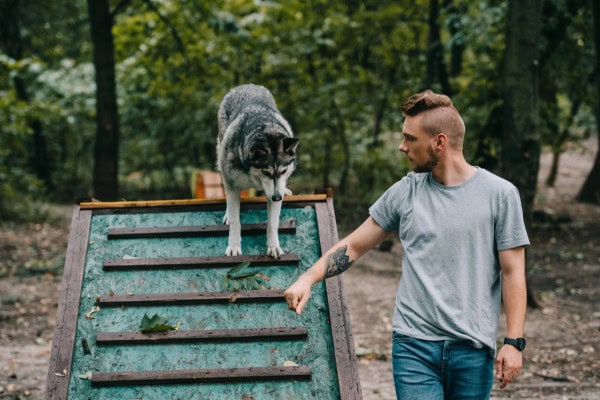
If your dog is physically active, dog agility training may be the ideal mentally-stimulating activity.
Agility training stimulates the brain because your dog must learn multiple different commands to understand when he or she must go over, under, or through an obstacle. Also, your dog has to learn how to assess the obstacles and respond appropriately. Plus, it’s a great way for both dog and dog parent to bond while getting some physical exercise too.
11. Toy sorting
If you are looking for a more advanced game to play with your dog, toy sorting may be the activity of choice. It challenges your dog because you are teaching him or her not only how to recognize and correlate specific toys with specific names or words, but also how to sort. And your dog needs to focus long enough to complete the task.
Toy sorting can be as simple or complex as you want for your dog. Some dogs play this game with only two or three toys at a time. Other dogs (especially some of the herding breeds like Border Collies) can sort tons of toys at a time. I had one patient who knew how to recognize 23 different toys, and could sort them four different ways. It was amazing to watch!
12. Learning a new trick
Almost everyone has heard the saying, “You can’t teach an old dog a new trick.” However, that statement is wrong. Senior dogs are just as capable of learning a new trick as puppies—they just may not move as quickly.
So, if you are looking for a way to provide mental stimulation to your dog at home, try helping your dog learn a trick. This is a great way to mentally stimulate dogs of any age. And it can even be done with dogs who are on crate rest (as long as they don’t become too excited and risk injuring themselves).
Tricks can be anything you want your dog to learn. Some of the most common tricks I have seen dog parents add to their dog’s normal trick list include:
- Shake
- Play dead
- Leave it (e.g. setting a treat on your dog’s paw and asking him or her to wait to eat it until told to do so)
- Picking up items (For example, my dog loves to pick up pens or pencils that I drop and bring them back to me.)
- Turning on the light switch
- Bashful
- Beg
- Dance
- Speak
And there are so many more! For an added challenge, you could incorporate hand signals for dogs into your dog’s repertoire. (Plus, hand signals come in handy if your senior dog experiences hearing loss in dogs or you need to communicate with your dog from far away.)
13. Go for a walk
I know this sounds simple compared to some of the other 12 options we have discussed. But please don’t underestimate the power of going for a walk with your dog.
Many dog parents don’t realize that going on a walk has the potential to do much more for a dog than just giving him or her a chance to have some exercise or a bathroom break.
On walks, dogs use all of their senses—but especially their sense of smell— to investigate and learn more about the environment around them. I know it can get frustrating when your dog stops every five seconds to sniff every bush or fire hydrant that you pass by on your walk. But sniffing is actually very good for a dog’s brain and provides so much mental stimulation.
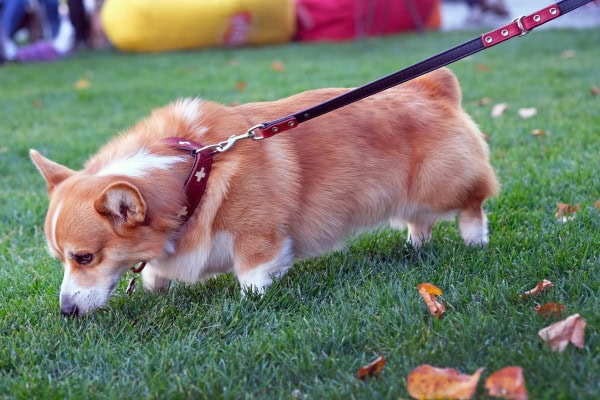
Sniffing provides great mental stimulation
In vet school, I learned that 10-20 minutes of sniffing on a walk can provide more mental stimulation for a dog than anything else throughout the day. Smelling the environment allows a dog to learn what is around them. And it releases endorphins and hormones in the brain that increase a dog’s happiness. This is supported by a small study showing that nosework increases optimism in dogs.
So, if you are looking for a way to mentally stimulate your dog, consider taking him or her for a walk.
If your dog is a senior and can’t walk very far due to arthritis or pain, even going outside and lying down on the ground for a few minutes each day can give your dog an opportunity to sniff and work the nose and brain. Or, you could also take your arthritic dog for a “walk” in a dog wagon or stroller.
For dogs on crate rest, you can take the crate outside and sit with your dog while they look around and sniff their surroundings from inside the crate. Just ensure that your dog doesn’t become overly excited while outside.
You can find a mental stimulation option for every dog
In this article I focused on 13 different ways to provide mental stimulation to your dog. But there are many other methods too. Whether you want to provide mental exercise for your dog through toys, food, or games, there is an option that would be fun and beneficial for every dog (and dog parent).
While providing mental stimulation becomes increasingly important for senior dogs, dogs with CCD, or dogs on crate rest, every dog can benefit from it. Plus, it is fun and a great method to increase the bond that you have with your dog. So why not pick one of these 13 options (or find a different one) and try it out with your dog? I think you will both enjoy it!
What is your dog’s favorite mental stimulation toy or activity?
Please comment below.


Hi Dr.
My 14 year old yorkie does seem to be senile…..her hearing is gone and she will hear clapping if I want her attention, her sight I believe is failing and she stands and stares into space seeming to wonder where she should go or is. she has had 38 teeth extracted last year and her tongue will hang out of side of mouth. she also hangs her head alot. What she does love is to eat! she knows exactly when it is time to eat and will run (her running is not fast. she is 5 lbs ) to her bowl. I make her soft treats which she loves and she travels with me all over in her bag in car or store but she sleeps so much and it is heartbreaking for me. I would like her to have fun again …she never seemed to be interested in toys..she has many. she is a rescue, I rescue yorkies and was used as a breeder I’ve been told. I’d appreciate any suggestions.
Hi Terree,
I am sorry your senior girl is starting to show some signs of decline. I understand your concern, but it sounds like she has a happy life and is still enjoying her days. Most of what you describe is consistent with early stages of dementia. There are many different supplements and therapies that can help minimize these symptoms (at least for a while). Here is a link to another article with more information and ideas to discuss with your vet: Signs of Dementia in Dogs: Stages, Symptoms & Treatment
Hoping you can find a way to maintain her quality of life for as long as possible. Wishing you both all the best and thank you for rescuing these loving little pups. ♥
Hi Dr. Buzby,
Firstly thank you so much for your website and newsletter, they have been invaluable resources for me and my senior pup!
I’m curious if you have any suggestions for me – My chihuahua will be 15 in September. He has some obsessive behaviors, namely scratching at the front door (even if we have just been out) and yelping over and over in the direction of his treats. These behaviors escalate when my partner and I are doing something he’s not included in (ie eating dinner) or most especially if I am watching TV – he protests wildly when the TV is on! Weirdly, he spends a lot of time at my parents home where the TV is on all day and he has no reaction over there (sleeps through it). He sometimes does these things if we are just doing things around the house too. It happens even if I take him out for a long walk and tire him out.
The only thing that helps to distract him is treats – he gets puzzles, frozen lick mat, treat ball, chews, etc. But I don’t want to overfeed him and I feel bad that he is so anxious. He has always been an anxious guy. Doesn’t really have the other CCD symptoms (not disoriented, he sleeps pretty well through the night, rarely has accidents, etc) but obviously this does feel related.
Any ideas? He is closely monitored by his vet.
Thanks so much!
Hi Izzy,
I am sorry you are dealing with this frustrating behavior with your senior pup. Without examining him myself, it is hard to make specific conclusions and recommendations. I am a bit suspicious that you may be accidentally rewarding these behaviors and encouraging them with giving treats when he is seeking attention. Is there any way to wait for him to calm down before offering the lick mat, chews, etc.? Or to give them when you know you are about to need some quiet time but before he has gotten himself all wound up? Also wondering if you could try a calming supplement or products that contain the dog appeasing pheromone (DAP collars, sprays, wipes, diffusers, and treats), or even CBD chews? You can also talk to your vet about an anti-anxiety medication that can be given as needed and not necessarily on a daily basis. Hoping you can find the answers you need to restore the peace in your home. Wishing you all the best and feel free to keep us updated on how things are going!
What do I do for 2 senior Labrador (14+) with walking issues? We do a very short walk and then they sleep all day!
Hi Tina,
Several of the activities and toys mentioned in the article would probably work for your Labs. Also, if you are looking for ways to get them outside more, you might consider taking them for a “walk” in a wagon. Take care and good luck with both of your senior pups!
My senior black and white Beagle rescue, Willie Nelson, a palliative foster, has very weak back legs. He also has no idea what to do with toys, has missing teeth and the ones he has are probably not very strong. I will try to find him a treat puzzle. BUT he absolutely loves to go for short walks. He gets so excited he stands by our driveway gate and whines when he sees me get his harness. I walk at whatever pace he chooses and stand and wait for as long as it takes for him to sniff whatever catches his nose fancy, He will walk in rain, no problem, so if its raining and not cold we go. He will gladly wear a raincoat. The only weather restrictions I have for him are very hot or very cold days.
Hi Janet,
Willie sounds like such a neat little pup! I am glad you encourage his love for walks and give him plenty of time to explore. Thank you for sharing his story with us. Best wishes to you and your sweet boy.
We play hide and seek. We let the dogs know we’re playing by bringing them together and letting them smell the treats. One of us hides little portions of a treat or some kibble throughout the house while the other one of us waits with the dogs in the other room. Once treats are hidden, we tell the dogs to seek and they run like crazy trying to find. We start out with some easy finds by putting some in obvious places unhidden. Then we make it increasingly difficult so they really have to use their nose. They really seem to enjoy this game! It’s best to count how many you place so you know if there are any still hidden. We’ll often find the dogs still looking even later in the day.
Hi Suzanna,
This is such a great idea! And what a wonderful way to get the whole family involved. Thank you for sharing your experience with us. Wishing you all the best for many happy days ahead. Keep up the good work!